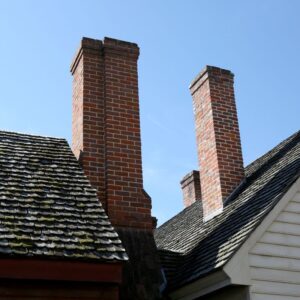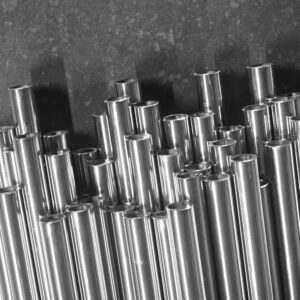It’s that time of the year again! The cool weather is creeping in and it’s time to light up your fireplace to take the chill out of the air. …but for some reason, your fireplace isn’t working as well as it should. A chimney is an intricate system with a lot of pieces. In order for your chimney to do its job, all of those components have to be in working condition.
One of the most important parts of your chimney system is the chimney liner – also called the flue liner. It serves a dual purpose by guiding smoke and harmful byproducts out of your home, as well as providing an insulating barrier against excessive heat. Although a damaged chimney liner can be repaired, there are times when a replacement is the better option.
If you think you need your chimney liner replaced, reach out to the crew here at The Chimney Guys. Schedule an appointment with us online or give us a call at 434-481-3796.
How Long Do Chimney Liners Last?
 You can go decades without needing to replace your chimney liner with the proper care! In fact, if you get annual inspections and chimney cleanings as recommended by the Chimney Safety Institute of America (CSIA), they can last between 15 and 20 years on average.
You can go decades without needing to replace your chimney liner with the proper care! In fact, if you get annual inspections and chimney cleanings as recommended by the Chimney Safety Institute of America (CSIA), they can last between 15 and 20 years on average.
With that being said, the lifespan of a chimney liner can hinge on a few different factors….
For instance, when a liner isn’t the right size or is installed incorrectly, it can cause creosote – a flammable byproduct of a wood-burning fire – to build up much faster than usual. Excessive amounts of creosote greatly increase the risk of a chimney fire, which will then cause damage to the liner. Similarly, a damaged or ill-fitting chimney cap can expose the liner to water damage, and it can crack if it takes on too much moisture unchecked.
The type of fuel you use and the material the chimney liner is made of can also affect how long it holds up. Although gas fireplaces don’t produce creosote like wood-burning units, they can still create acidic condensation that can corrode chimney liners, especially if the liner is not properly insulated.
It’s also important to note that some liners stand the test of time better than others. Aluminum liners have shorter lifespans compared to stainless steel and clay tile chimney liners – they may need to be replaced in as little as five years.
Signs It’s Time to Replace Your Chimney Liner
If you suspect there’s trouble brewing with your chimney liner, schedule an inspection with a CSIA-certified chimney technician, like one our techs. Annual inspections give us the ability to track changes in the chimney liner over time, and we can extend its lifespan by making repairs before they cause too much damage.
It’s not always possible to tell when your chimney liner needs to be replaced, but the following signs could point to a compromised chimney liner:
- The damage is visible. Take a flashlight and look up the interior of the chimney to see if you can spot cracks, gaps, or missing mortar joints in the liner. Cracks can allow heat, smoke, and gases to escape into the surrounding structure – which is a big safety risk.
- Creosote is accumulating more quickly. A heavy buildup of creosote on the chimney liner’s surface can be an indication that the liner is not functioning correctly.
- You notice flakes. Shards in the fireplace could be due to chipping tile if you have a clay tile liner. Flakes could also be bits of creosote that have broken away.
- There are signs of a water leak. There are a lot of potential access points for water to enter your chimney system, and a damaged chimney liner is one of them. Water stains on the interior or exterior of your chimney could be due to a weakened liner that’s allowing water to penetrate the chimney.
- There’s rust. For metal chimney liners, rust or corrosion can be a clear sign of liner deterioration. This is common in older stainless steel and aluminum liners.
- Sudden smokiness and odors. Gaps or damage in the liner can’t direct gases out of your home and they may back up into your living space, causing an increase in smoke and foul smells.
- The chimney liner is old. The age of your chimney liner is a big deal. Even well-maintained liners can suffer from wear and tear. If your liner is nearing the end of its expected lifespan, it’s a good idea to consider relining.
What Are the Benefits of a Stainless Steel Liner?
There are several options for homeowners when it’s time to reline your chimney. At The Chimney Guys, we believe that stainless steel liners offer the best bang for your buck – without sacrificing quality. Why is this?
 It’s safer. Stainless steel liners improve the safety of your chimney and home. They’re more effective at containing combustion byproducts (such as carbon monoxide), preventing them from leaking into your home.
It’s safer. Stainless steel liners improve the safety of your chimney and home. They’re more effective at containing combustion byproducts (such as carbon monoxide), preventing them from leaking into your home. - It’s durable. Stainless steel is very durable and resistant to corrosion, so you can limit future chimney repairs and expenses.
- It’s easy to install. Don’t want the headache of a long project? Stainless steel liners are relatively easy to install and can be customized to fit different chimney setups.
- It doesn’t crack easily. Stainless steel liners are less prone to cracking and damage from heat-related stress than clay tile liners, which can crack when exposed to extreme temperature changes.
- It’s versatile. Stainless steel liners can handle a wide range of fuel sources, including wood, gas, and oil.
Hire Us for Your Chimney Liner Replacement
A damaged chimney liner impacts your ability to safely use your fireplace. Not only is it harder to use, it’s a fire hazard waiting to happen. If you think there’s a problem, don’t hesitate to call The Chimney Guys. Our trusted and knowledgeable chimney technicians are ready to help. Dial 434-481-3796 or schedule an appointment online today.

Recent Comments